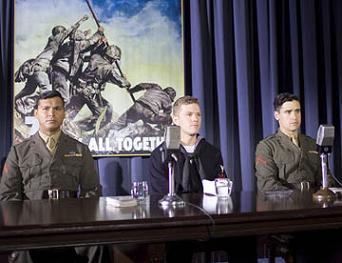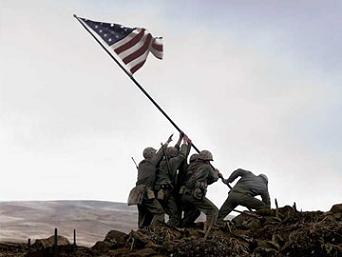

Like a fine wine, filmmaker Clint Eastwood gets better with age. He is seventy-six years old, but each successive movie he makes is better than the last. And these films tower above most other filmmakers today. Eastwood (Million Dollar Baby, Mystic River) has a special gift for finding the humanity within a situation. He doesn't need to be loud or brash. He cuts right into the heart of the matter in the most efficient way possible. Flags of Our Fathers is a bit of a change for him. The movie, about the world famous photograph of soldiers on Iwo Jima raising the flag, is based on the novel by James Bradley and Ron Powers. This sheer scale of the film is something new for Eastwood, who steps into Steven Spielberg (who produced the movie) territory by showing war at its most brutal.
Eastwood and adapters William Broyles, Jr. (Jarhead, The Polar Express) and Paul Haggis (The Last Kiss, Million Dollar Baby) cut back and forth between three time periods - the battle of Iwo Jima, the ensuring heroes tour, and the present, where James Bradley (Tom McCarthy, All The King's Men, Syriana) interviews survivors as he writes a book about his father John "Doc" Bradley, and the battle. Bradley (Ryan Phillippe, Crash, Igby Goes Down), Ira Hayes (Adam Beach, Windtalkers, Joe Dirt) and Rene Gagnon (Jesse Bradford, Happy Endings, Heights) were the only three survivors from the second flag raising (the one that was the subject of the iconic photograph by Ned Eisenberg). The military flew the three back to the United States for a bond tour. They were celebrated as heroes and feted everywhere they went, all the while doubting their own heroism.
The actual flag raising occurs well into Flags of Our Fathers. The primary focus of the movie is not the battle, but the effect of the battle on Bradley, Hayes, and Gagnon. To this effect, the battle scenes on Iwo Jima are bloody to the extreme, with dismembered limbs, dead bodies, and blood everywhere. Their friends and fellow soldiers die in all sorts of grisly ways, and again, it is baffling why this sheer level of violence was not enough to merit an NC-17. The Marines are thrown into this powder keg, and told they must capture Mount Suribachi in order to claim the island. This means scaling a large mountain full of hidden Japanese soldiers.
The horrific battles on Iwo Jima serve primarily to add context to the way that the three soldiers feel back in America. All three have different reactions. Gagnon loves the spotlight, and revels in the attention and job offers. Bradley is a bit ambivalent towards everything. The most touching reaction comes from Hayes, who wants nothing to do with the tour. He feels ashamed that he is parading around while fellow soldiers die. To Hayes, the real heroes are the people who died on the island. It was just a fluke that he survived. Beach gives a remarkable performance, better than anything he's ever done before in his career. His confusion, frustration, and sadness are real. Hayes has no way to cope, and seeks escape in the form of alcohol. It is moving, and adds a sense of depth to the movie. Eastwood personalizes the war to the viewer. Yes, there are loud explosions and long shots of hundreds of soldiers fighting, but the movie is really about the individual, and how war affects each person.